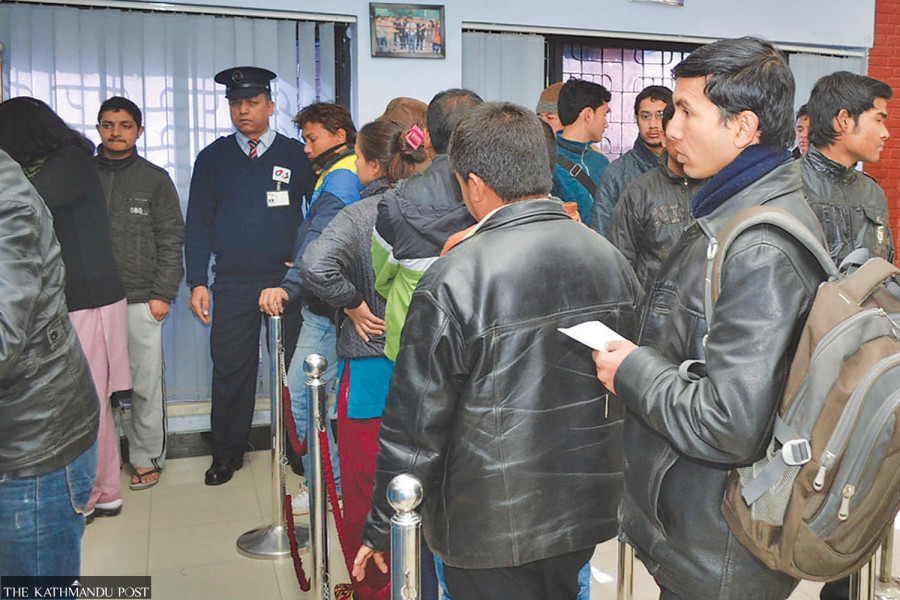National
Banks told to prepare risk matrix to tackle money laundering and terror financing
Nepal Rastra Bank’s new guidelines require banks to assess risks related to banking products and services, customers, delivery channels and geographical locations.
Prithvi Man Shrestha
The Nepal Rastra Bank has instructed the banks and financial institutions to assess the risk of money laundering and terror financing through the banking system. They have been asked to calculate the probability of vulnerability and the magnitude of potential consequences if the risk is not properly addressed.
In a set of risk assessment guidelines issued by the central bank on Sunday, the banks and financial institutions have been asked to prepare a risk matrix involving the likelihood and scale of such threat and vulnerability and the scale of consequences.
The likelihood scale can be ‘very unlikely,’ ‘unlikely,’ ‘likely,’ ‘very likely’ and ‘most likely’ while the scale of the consequences can be ‘minimal,’ ‘minor,’ ‘moderate,’ ‘significant,’ and ‘severe,’ according to the guidelines.
For example, financial institutions may consider domestic tax evasion criminals as a threat, and accounts dealing with cash payments as a vulnerability, the guidelines suggest.
“Depending on the risk assessment method used, this could result in a likelihood scale rating of very likely, according to the guidelines. “Financial institutions may then assess the impact of this event on their business and the wider environment.”
Central bank spokesman Gunakar Bhatta said the guidelines were issued to guide the market on how they should calculate the risks related to money laundering and terror financing. “As a joint evaluation of Nepal’s performance regarding money laundering and terrorist financing is ongoing, this move is expected to help Nepal get better marks in the evaluation.”
The Asia/Pacific Group on Money Laundering, a regional anti-money laundering body, is currently conducting an evaluation of Nepal.
According to the central bank, the risk assessment is the first step that must be taken before developing an anti-money laundering and terrorist financing programme. “A risk-based approach allows some flexibility for the financial institutions in the steps to meet anti-money laundering and terrorist financing obligations,” it said.
The National Risk Assessment Report (on Money Laundering and Terrorist Financing)-2020 has identified corruption, tax evasion, and financial crimes including banking offences and hundi as major threats.
Drugs trafficking, organised crime, extortion, arms-related offence, domestic terrorism, fraud, counterfeiting of currency, environment-related crime, robbery (theft), smuggling (including black marketing in goods) and forgery as threats of concern.
The Nepal Rastra Bank (NRB), has called for identifying the risk under several categories including products and services, types of customers, delivery channels, and geographical locations.
According to the NRB, varying degrees of money laundering and terrorist financing might be involved in the products and services offered by financial institutions.
“Some of the products may foster a higher degree of anonymity, use a larger volume of cash or involvement of third-party agents compared to other products,” the set of guidelines states. “Thus, during the assessment process, financial institutions must be heedful of the transaction volume, average transaction size, exposure to foreign transactions, level of cash activity, complexity, and transparency of the products and services offered by them.”
Some of the questions to be considered while assessing the risk in a product or service are whether they allow for anonymity, whether they allow customers to conceal the source of wealth or funds, and whether the product or service allows payment to parties, among other things.
When it comes to the risk associated with customers, the central bank has called for assessing the risk based on the type of customers, as some categories of customers pose a higher risk than others.
Financial institutions need to determine the breakdown of their customer base; assessing where the customers originate from or the types of transactions they are performing, and how they use the products/services of the financial institution, according to the guidelines.
A breakdown of customers can be—senior political figures and their immediate family members and their close domestic and foreign associates; foreign corporations, particularly offshore corporations particularly located at high-risk geographic locations; cash incentives businesses such as petrol pumps, retail stores and restaurants; professional services; and housewives and maids, among others.
In order to mitigate the risks in the areas of delivery channels, financial institutions should consider the related risk factors to the extent that the business relationship is conducted on a non-face-to-face basis, any introducers or intermediaries used and the nature of their relationship, according to the guidelines. “This should be performed during further transactions carried out with the customer,” the guideline states.
When it comes to the risks arising from the specific locations involving the customers, the financial institutions have to ensure that they understand the links between their customers and the different jurisdictions they operate in, transact with or originate from, so that an effective assessment of the risk can be undertaken.
For example, international higher-risk geographical locations generally include jurisdictions or countries monitored for deficiencies in their regimes to combat money laundering and terror financing by international entities; countries with ineffective anti-money laundering measures; countries with a high level of organised crime and countries with a high prevalence of bribery and corruption.
For example, Nepal has been receiving a significant amount of foreign direct investment from the British Virgin Islands, a tax haven.




 12.12°C Kathmandu
12.12°C Kathmandu













%20(1).jpg&w=300&height=200)

